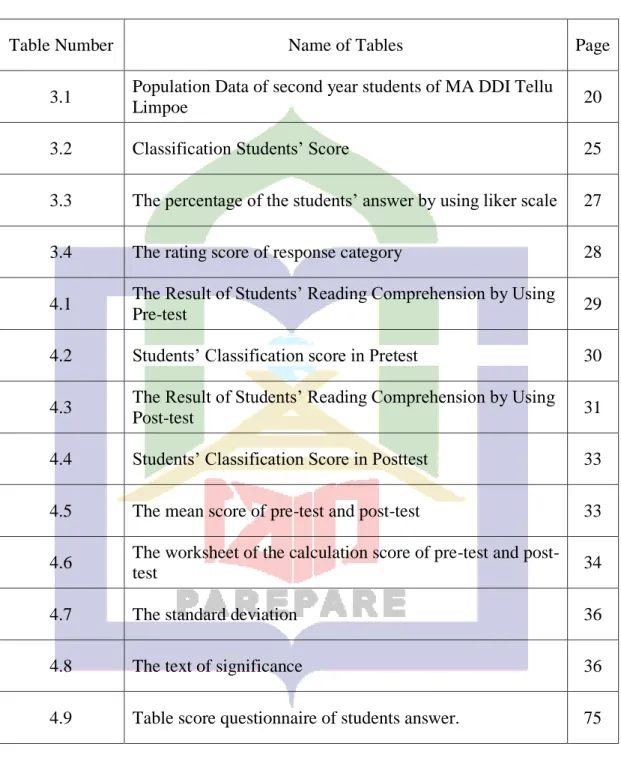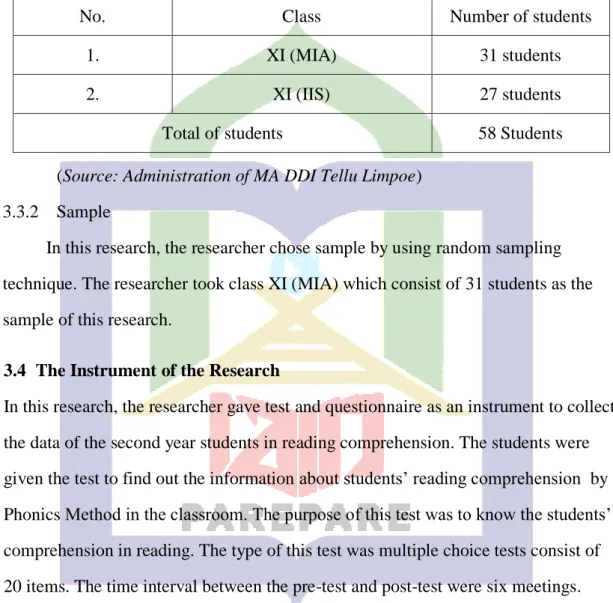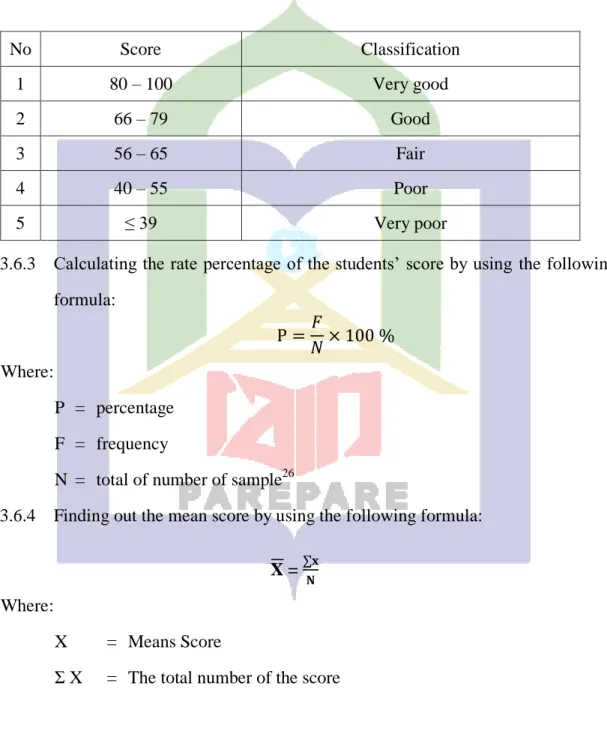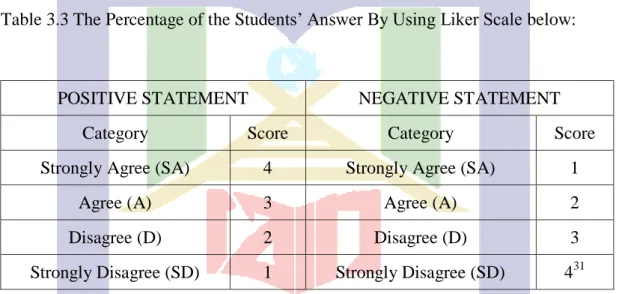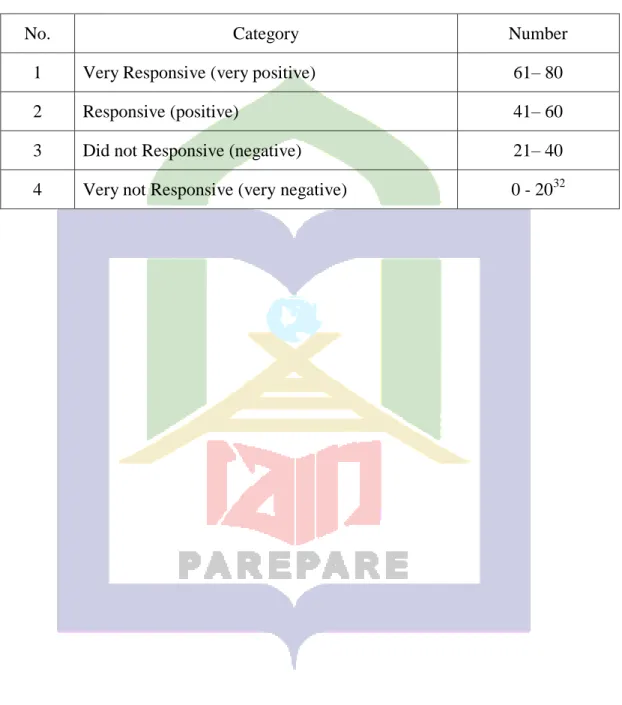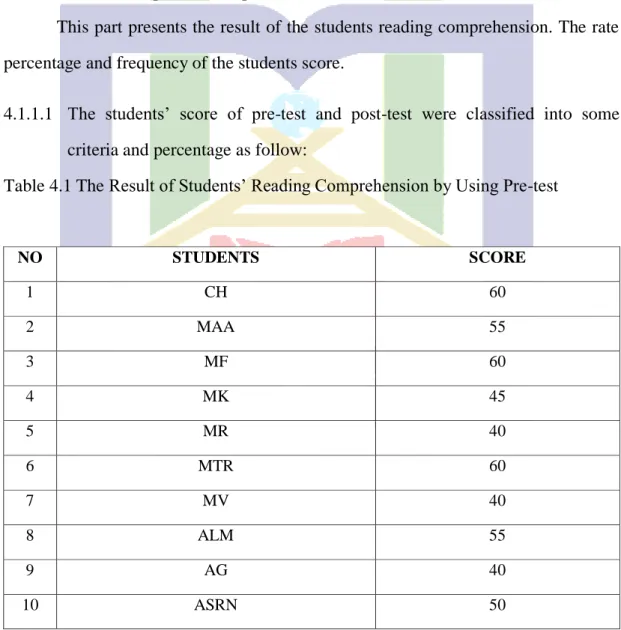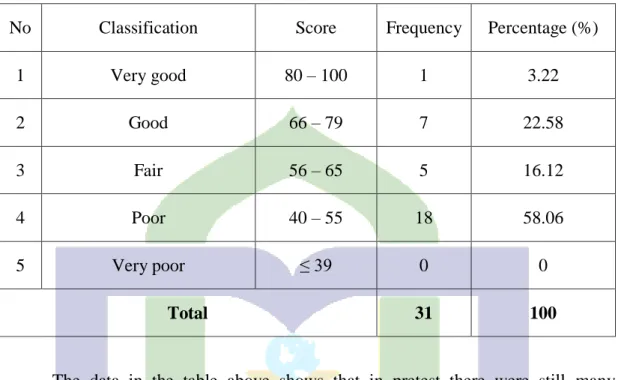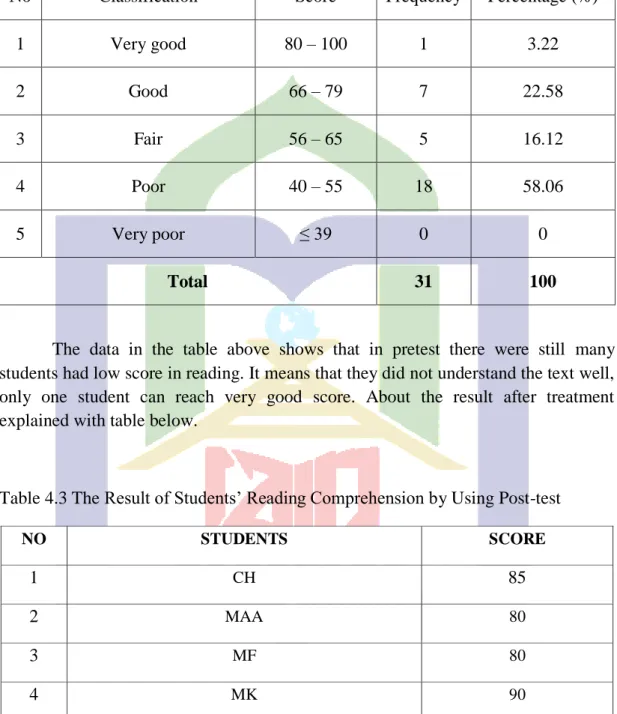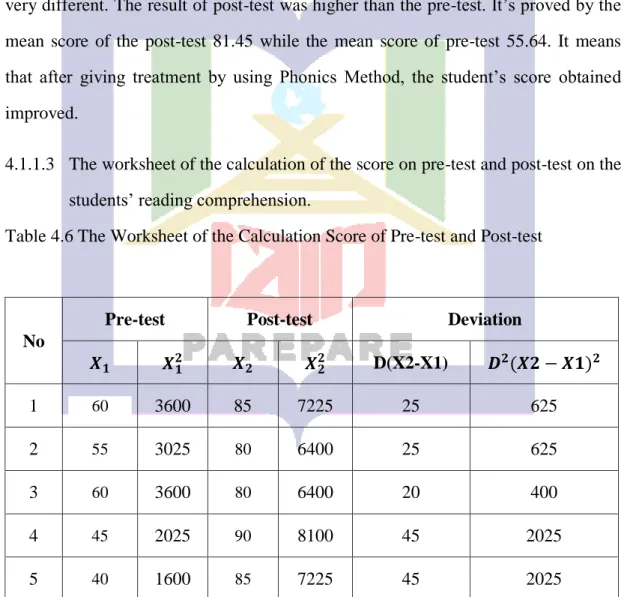SKRIPSI
IMPROVING THE STUDENTS’ READING COMPREHENSION THROUGH PHONICS METHOD AT THE SECOND YEAR
STUDENTS OF MA DDI TELLU LIMPOE KAB. SIDRAP
By
NURSYAFITRI Reg. Num. 15.1300.011
ENGLISH EDUCATION PROGRAM TARBIYAH FACULTY
STATE ISLAMIC INSTITUTE (IAIN) PAREPARE
2020
ii SKRIPSI
IMPROVING THE STUDENTS’ READING COMPREHENSION THROUGH PHONICS METHOD AT THE SECOND YEAR
STUDENTS OF MA DDI TELLU LIMPOE KAB. SIDRAP
By
NURSYAFITRI Reg. Num. 15.1300.011
Submitted to the English Education Programof Tarbiyah Faculty of State Islamic Institute of Parepare in Partial of Fulfilmentof the Requirements for
the Degree ofSarjana Pendidikan (S.Pd)
ENGLISH EDUCATION PROGRAM TARBIYAH FACULTY
STATE ISLAMIC INSTITUTE (IAIN) PAREPARE
2020
iii
IMPROVING THE STUDENTS’ READING COMPREHENSION THROUGH PHONICS METHOD AT THE SECOND YEAR
STUDENTS OF MA DDI TELLU LIMPOE KAB. SIDRAP
Skripsi
As Partial Fulfillment of the Requirement for the Degree of Sarjana Pendidikan (S.Pd)
English Education Program
Submitted by
NURSYAFITRI Reg. Num. 15.1300.011
to
ENGLISH EDUCATION PROGRAM TARBIYAH FACULTY
STATE ISLAMIC INSTITUTE (IAIN) PAREPARE
2020
iv
ENDORSEMENT OF CONSULTANT COMMISSIONS
Name of the Student : Nursyafitri
The Title of Skripsi : Improving the Students’ Reading Comprehension through Phonics Method at the Second Year Students of MA DDI Tellu Limpoe Kab. Sidrap Student Reg. Number : 15.1300.011
Faculty : Tarbiyah
Study Program : English Education
By Virtue of Consultant Degree : SK. The Dean of Tarbiyah Faculty Certificate No. B.471/In.39/FT/04/2019
Has been Legalized by Consultants
Consultant : Drs. Amzah, M.Pd.
NIP : 19671231 200312 1 011
Co-Consultant : Mujahidah, M.Pd.
NIP : 19790412 200801 2 020
Approved by:
v SKRIPSI
IMPROVING THE STUDENTS’ READING COMPREHENSION THROUGH PHONICS METHOD AT THE SECOND YEAR
STUDENTS OF MA DDI TELLU LIMPOE KAB. SIDRAP
Submitted by
NURSYAFITRI Reg. Num. 15.1300.011
Had been examined on February,12th, 2020 and had been declared that it fulfilled the requirements
Approved by Consultant Commissions
Consultant : Drs. Amzah, M.Pd.
NIP : 19671231 200312 1 011
Co-Consultant : Mujahidah, M.Pd.
NIP : 19790412 200801 2 020
vi
ENDORSEMENT OF EXAMINER COMMISSIONS
The Title of Skripsi : Improving the Students’ Reading Comprehension through Phonics Method at the Second Year Students of MA DDI Tellu Limpoe Kab. Sidrap Name of the Student : Nursyafitri
Student Reg. Number : 15.1300.011
Faculty : Tarbiyah
Study Program : English Education
By Virtue of Consultant Degree : SK. The Dean of Tarbiyah Faculty Certificate No. B.471/In.39/FT/04/2019
Date of Graduation : February, 12th, 2020 Approved by Examiner Commissions
Drs. Amzah, M.Pd. (Chairman)
Mujahidah, M.Pd. (Secretary)
Dr. Ahdar, M.Pd. I (Member)
Wahyu Hidayat, Ph. D (Member) Cognizant of:
vii
ACKNOWLEDGEMENTS
ِن ْحَّْرلا ِالله ِمْسِب ِمْيِحَّرلا
In the name of Allah, The beneficent and The Merciful
Alhamdulill𝑎hirabbil𝑎lam𝑖n, the writer expresses her highest gratitude to the God Allah swt.to be the one transcendent creator, lord and master of all, who has given the writer good health, blessing, mercy and finish this skripsi. Shalawat and salam to the prophet Muhammad saw. Peace be upon him. Who has guided us to choose the best way of life namely Islam.
In arranging this research, the writer would like to thank to all people have provided motivation, advice, and support for the writer. In this valuable chance, the writer intended to express her gratitude and appreciation to all of them. She realizes that without their support and help, she could not be able to finish this “Skripsi”. So In this opportunity, the writer would like to express especially thanks to her beloved parents and family who have given their endless love, advice, support and pray to God for writer’s success.
Her high appreciation and profusely sincere thanks are due to Drs. Amzah, M.Pd. as the first consultant and Mujahidah, M.Pd. as the second consultant who have patiently guided and given their construction, suggestion, motivation and correction to the writer in finishing this skripsi.
Besides that the writer also deliver special thanks to:
1. Dr. Ahmad Sultra Rustan, M.Si.,as the Rector of IAIN Parepare who has worked hard to manage education at IAIN Parepare.
viii
2. Dr. H. Saepudin, S.Ag., M.Pd., as the Dean of Tarbiyah Faculty of IAIN Parepare, who has arranged a positive education for the students in the Faculty of Tarbiyah.
3. Mujahidah, M.Pd., as the Chairman of English Education Program for the fabulous serving to the students.
4. The lectures of English Education Program who have already taught the writer during her study in IAIN Parepare.
5. Fatimah, S.Pd., M.Pd.,as the Headmaster of MA DDI Tellu Limpoe who has allowed the writer to conduct and observe the research at the school.
6. Rismawinarti, S.Pd.,as the English Teacher of MA DDI Tellu Limpoe who has given the writer advices and change in teaching and doing the research.
7. All of the students at the second year students of MA DDI Tellu Limpoe as the object of the research.
8. The writer wants to give her sincerest gratitude to her beloved parents, Rustan and Dahlia for their endless love and support also always pray for her until the Degree of Strata-I (S1), and her beloved brothers Fahrul and Sahrul who never stop asking about the completion of my study. Their text messages keep me annoyed but magically give me reason to be focus to finish my study as soon as possible, for that I am really grateful to have them in my life.
9. Her husband Amir who never stop asking about the completion of the study.
10. Her best friends; Riska Yunita and Andi Hapsa Mulinda who always accompanied her start from the first semester until now.
11. Her other best friend in cottage “Full House”: Hasmia, thank you for being such a good neighbor who always ready to help and push her to finish the research.
ix
12. Her friends in English Departement Tarbiyah Faculty 2015. Thanks for giving support and sharing their time and being good friends.
13. All people who have given their help in writing this ”Skripsi” that the writer could not mention it one by one.
Finally, the writer realized that this skripsi cannot be considered perfect without critiques and suggestion. Therefore, it is such a pleasure for her to get critiques and suggestion to make this skripsi better. Hopefully, this skripsi will be useful for all of us and for the development of English Teaching and Learning.
Aamiin.
Parepare, February 20th, 2020 The writer,
Nursyafitri
Reg. Num. 15.1300.011
x
DECLARATION OF THE RESEARCH AUTHENTICITY
The writer who signed the declaration below:
Name : Nursyafitri
NIM : 15.1300.011
Place and Date of Birth : Mangkoso, 10 September 1997 Study Program : English Education Program
Faculty : Tarbiyah
Skripsi Title : Improving the Students’ Reading Comprehension through Phonics Method at the Second Year Students of MA DDI Tellu Limpoe Kab. Sidrap
Stated that herself conducted this skripsi, if it can be proved that is copied, duplicated or complied by other people, this skripsi and degree that has been gotten would be postponed.
Parepare, February 20th, 2020 The writer,
Nursyafitri
Reg. Num. 15.1300.011
xi ABSTRACT
Nursyafitri. Improving the students’ reading comprehension through phonics method at the second year students of MA DDI Tellu Limpoe Kab. Sidrap.
(Supervised by Amzah and Mujahidah).
This study aimed to see the improvement of Reading Comprehension at the second year students of MA DDI Tellu Limpoe. The objective of this research were to measure the students’ reading comprehension between the students who are taught by using phonics method in reading comprehension. The population of this research were the second year students consists of XI MIA (31 students) and XI IIS (27 students) . The sample took by using random sampling.
The research method used in this research was a quantitative method using pre-experimental method. The data was collected through pretest, posttestand questionnaire. Pretest and posttest to know whether Phonics Method in teaching reading can improve students’ reading comprehension. The researcher used questionnaire to know the students response toward phonics methodin improving reading comprehension.
Based on the calculation, the result of the data analysis by using t-test showed the value of t-test (to) was higher than ttable (tt), to >tt = (9.20 > 1.69) in significant degree of 0.05% (5%). It means that the Alternative Hypothesis (Ha) was accepted and the Null Hypothesis (Ho) is rejected. In conclusion, Phonics Method is able in improving students reading comprehension. From 10 positive and 10 negative questionnaires. All the students’ answered positive and most of them got 61% - 80%.
The main score of the students was 69.70 from 31 students. in conclusion, the students responses in learning reading comprehension through phonics method.
Keywords: Reading comprehension, Phonics Method.
xii
LIST OF CONTENTS
COVER ... i
COVER OF TITLE ... ii
SUBMITTED OF PAGE ... iii
ENDORSEMENT OF CONSULTANT COMISSIONS ... iv
APPROVED OF CONSULTANT COMISSIONS ... v
ENDORSEMENT OF EXAMINER COMISSIONS ... vi
ACKNOWLEDGEMENT ... vii
DECLARATION OF THE AUTHENTICITY OF THE SKRIPSI ... x
ABSTRACT ... xi
LIST OF CONTENTS ... xii
LIST OF TABLES ... xiv
LIST OF APPENDICES ... xv
CHAPTER I INTRODUCTION 1.1 Background ... 1
1.2 Problem Statement ... 3
1.3 The Objective of the Research ... 3
1.4 Significance of the research ... 4
CHAPTER II REVIEW OF RELATED LITERATURE 2.1 Previous Research Findings ... 5
2.2 Some Pertinent Ideas ... 6
2.3 Conceptual Framework ... 17
2.4 Hypothesis ... 18
2.5 Operational Definition of Variable ... 18
xiii
CHAPTER III METHODOLOGY OF THE RESEARCH
3.1 Research Design ... 19
3.2 Location and Duration of the Research ... 19
3.3 Population and sample ... 19
3.4 Instrument of the Research ... 20
3.5 Procedure of Collecting Data ... 20
3.6 Technique of Data Analysis ... 24
CHAPTER IV FINDINGS AND DISCUSSION 4.1 Findings ... 29
4.2 Discussion ... 37
CHAPTER V CONCLUSION AND SUGGESTION 5.1 Conclusion ... 43
5.2 Suggestion ... 44
BIBLIOGRAPHY. ... 45
APPENDICES... 47
xiv
LIST OF TABLES
Table Number Name of Tables Page
3.1 Population Data of second year students of MA DDI Tellu
Limpoe 20
3.2 Classification Students’ Score 25
3.3 The percentage of the students’ answer by using liker scale 27
3.4 The rating score of response category 28
4.1 The Result of Students’ Reading Comprehension by Using
Pre-test 29
4.2 Students’ Classification score in Pretest 30 4.3 The Result of Students’ Reading Comprehension by Using
Post-test 31
4.4 Students’ Classification Score in Posttest 33
4.5 The mean score of pre-test and post-test 33
4.6 The worksheet of the calculation score of pre-test and post-
test 34
4.7 The standard deviation 36
4.8 The text of significance 36
4.9 Table score questionnaire of students answer. 75
xv
LIST OF APPENDICES
Number The Title of Appendices Page
1 Instrument of the Pre-test, Post-test and Questionnaire 50
2 Lesson Plan 56
3 The Students’ Pre-test, Post-test and Questionnaire 62
4 Distribution of T-table 70
5 Research Allowance 71
6 The Documentation 74
7 Data Analysis 77
8 Curriculum Vitae 80
1 CHAPTER I INTRODUCTION 1.1 Background
Reading is one of the four language skills that taught in English language learning process besides listening, speaking and writing. However, among of all the skills reading is considered as the most important skill. The people’s daily life and reading activity are closely related because reading is not only useful in the world of education, but also in social and working life.
An important aspect in learning English is reading and it needs to be improved.
There are some reasons why reading very important to increase; firstly, reading takes an important role in learning process because one of ways to get information is using reading and also it can facilitate the students to enrich their knowledge. Secondly, reading is not only to give information but also reading makes the students can pleasure and enjoy. The material must interest for the students so that the students can get best result from learning process of reading. But what happens now, there are many students have difficulties in reading text material. They cannot comprehend what they read and automatically they less some information because they have no skill in comprehending the texts material.
Reading for comprehension is skill involves absorbing the content of the text.
The students cannot look for specific points only, but also we need to get and overall understanding of the text. Comprehension is much needed to understand the meaning of the text or written information.
In the process of teaching reading, the students have an experience errors.
These errors can be in the form of errors recognizing letters, words, sentences that are all seen in the sound that is spoken. Therefore, efforts to grow and develop reading skills in students need to practice repeatedly and intensively guidance given by the teacher, and it is expected that reading errors for students can be avoided. English reading activity is very important in improving reading skills for students. However, in reality, many students are not yet aware of this. They tend to spend more of their time watching TV and other less important things. This is also experienced by students at the MA DDI Tellu Limpoe.
Based on the observation at MA DDI Tellu Limpoe, the researcher found that the students in understanding of the reading English texts were quite low. This may be caused by various factors, such us: (a) Students had limited vocabulary, (b) Students’ lack of interest in improving their reading ability, (c) Lack of learning support, (d) Lack of language knowledge, (e) Pronunciation difficulties, (f) Lack of knowledge of words, phrases, paragraphs, and passage or texts, (g) Lack of reading application of reading strategies and Lack of reading motivation.
In teaching reading, the teacher should have the ability to guide students in learning reading. However, sometimes the technique used by the teacher makes the students inactive, bored and they do not participate in teaching and learning process in the classroom. So the researcher tries to carry out this research with phonic method.
3
Phonics will be defined as the systematic and explicit instruction of letter-sound correspondence.1The goal of phonics instruction is to help students develop the alphabetic principle. Students who understand the alphabetic principle know that the sounds of spoken words are mapped onto written words in systematic ways. As students develop understandings of this principle, they become adept at using letter- sound correspondences to figure out unrecognized words. Command of the alphabetic principle is the foundation for accurate word recognition and a prerequisite for fluency well-documented characteristics of skillful readers.
Grayling states that one way to help students to improve upon their reading habits is by using the phonic method.2Phonic method emphasizes words through the process of listening to the sound of letters. At first the students are invited to recognize the sounds of letters then the letters become syllables and words. Then, words become sentence. And then the students are invited to read the text completely.
By using Phonics Method, the researcher tries to makes students reading easily, because the students follow what the teacher reads.
Based on the explanation above, the researcher is interested to conduct a research about “Improving Students’ Reading Comprehension through Phonics Method at The Second Year Students of MA DDI TelluLimpoe Kab. Sidrap”.
1.2 Problem Statement
Based on the background of the study stated above. The research problems are:
1Maddox K & Feng J, Whole Language Instruction vs Phonics Instruction: Effect on Reading Fluency and Spelling Accuracy of First Grade Students (Georgia, 2013),p.5.
2Abdul Wahab Adam Hamid, “Assisting T I Ahmadiyya Junior High Students Improve Upon Their Reading and Comprehension Skills Using the Phonics Method” (Ghana: University for Development Studies,2018), p.29.
1.2.1 Is phonics method able to improve students’ reading comprehension at MA DDI Tellu Limpoe Kab.Sidrap?
1.2.2 How is the students’ response toward phonics method at MA DDI Tellu Limpoe Kab.Sidrap?
1.3 Objectives of the Research
Based on the problem statement of the research above, the objective of this research are:
1.3.1 To know whether Phonics Method can improve students’ reading comprehension or not.
1.3.2 To know the students response toward phonics methodin improving reading comprehension.
1.4 Significance of the research
The researcher hopes that the results of this study can be used by theresearcher, students,teacherforthe following purposes:
1.4.1 For the researcher, this researcher expected to give a new knowledge of the further of researcher to do the better research of teaching and learning cases and also to solve the students’ reading problem
1.4.2 For students, it helped students to increase reading comprehension and their interest to be more active in teaching learning process.
1.4.3 For the teacher, the result of the study can be used as an alternative teaching technique to improve students’ reading comprehension.
5 CHAPTER II
REVIEW OF RELATED LITERATURE
This section presents the theories that are related to the study. This section is divided into five parts, which are some previous related research findings, some pertinent ideas, conceptual framework, action hypothesis, variable and operational definition.
2.1 Previous Research Findings
Many researchers have conducted research in relation to the students’
comprehending English text as follows:
Gabriel Kwame Ankrah in his research “Using Phonics Method to Improve Poor Reading Ability of Pupils at Techiman Senior High School Form One” said that the use of Phonics Method could improve poor reading ability. The improvement of the students’ poor reading ability could be seen from the mean score of pre test, that was (2,24), post test was (8,8). Thus, it can be conclude that Phonics Method could be used to improve poor reading ability.3
Mariana in her research “Improving Reading Comprehension by Using IBT Method (Inquiry Based Teaching) at the Tenth Grade of MA Izzatul Ma’arif Tappina Kab. Polman”, said that the use of IBT (inquiry based teaching) Method could improve students’ reading comprehension. The improvement of the students’ reading comprehension could be seen from the mean score of pre test, that was (2,02), posttest was (3,40). Thus the researcher suggested that IBT could be used as a
3Gabriel Kwame Ankrah,Doris Nyanta, danKwasiOpoku, “Using Phonics Method to Improve Poor Reading Ability of Pupils at Techiman Senior High School form One,” (Unpublished by European Journal of Education Studies3, no. 6, 2017).
method to help students in learning especially in getting their reading comprehension.4
Heri Priyanti in her research “The Use of Snowball Throwing Method to Improve Students’ Reading Comprehension at the Eleventh Grade of MAN 1 Parepare” said that the use of snowball throwing is able to improve the students’
reading comprehension. The enhancement of the students’ reading comprehension is also supported by the result of the test score. The mean score of pre test was 64,3 andit improved into 75,8 in the post test. Thus, it can be conclude that snowball throwing method can improve students’ reading comprehension.5
Based on the various related research findings above, the researcher could conclude that in improving reading comprehension, the teacher should be more creative to apply some various technique or even method to make the students more interested in learning. Previous researchers used phonics method to improve poor reading ability of Pupils at Techiman Senior High School form One in Ghana, and In this research the researcher tries to use Phonics Method that would be useful for teaching reading comprehension in Indonesia.
2.2 Some Pertinent Ideas
2.2.1 The Concept of Reading Comprehension 2.2.1.1 Definition of Reading
Reading is a complex process in which the recognition and comprehension of written symbols are influenced by reader’s perceptual skill, decoding skill,
4Mariana, “Improving Reading Comprehension by Using IBT Method (Inquiry Based Teaching) at The Tenth Grade of MA Izzatul Ma’arif Tappina Kab. Polman” (Unpublished Skripsi IAIN Parepare, 2019)
5Heri Priyanti, “The Use of Snowball Throwing Method to Improve Students’ Reading Comprehension at The Eleventh Grade of MAN 1 Parepare” (Unpublised Skripsi IAIN Parepare, 2018)
7
experience, language backgrounds, mind sets, and reasoning abilities as they anticipate meaning on the basis of what has been read. The total process is a Gestalt, or whole; a serious flaw in any major function or part may prevent adequate performance.6
Albert, Harris J and Sipay states that “reading is meaningful interpretation of printed or written verbal symbols. Reading (comprehending) is a result of between the perception of graphic symbols that represent language and the reader’s language skills and knowledge of the world”.7
Reading is useful for other purpose too: any exposure to English (provided students understand it more or less) is a good thing for language students. At the very least, some of the language sticks in their minds as part of the process of language acquisition, and if the reading text is especially interesting and engaging, acquisition is likely to be even more successful.8
Based on the explanation above, the researcher concluded that reading is an important skill that can make the people interacted with other people.
2.2.1.2 Kinds of Reading 2.2.1.2.1 Reading Aloud
Reading aloud is an important thing to do in reading where the students who are known as a reader are required it read aloud to practice their tongue about have to pronounce every word found in the reading text. The main point of focus in reading aloud is not catching their ideas every word in a sentence.
6Albert, Harris, J & Sipay, Edward R,How to Increasing Reading Ability (London: Longman, 1975), p.10.
7Albert, Harris, J & Sipay, Edward R, How to Increasing Reading Ability, p. 8.
8Harmer, J, How to Teach English (1988), p. 68.
2.2.1.2.2 Silent Reading
Silent reading is frequently practice by a reader who wants to comprehend text in reading process. Silent reading means reading by gears, where no voice expressed.
This type of reading aims it find out the word and how to express the word as in reading aloud. Reading silent needs a reader should have a full concentration.
2.2.1.2.3 Speed Reading
Speed reading is used to improve speed comprehension in reading. This must run by side with the main purpose of reading that is comprehension it depends on the kinds of material of reading. The rate of speed of reading a story or newspaper or narrative will be different from the reading of scientific material.9
Based on the explanation above, reading aloud is the reader read something loudly, silent reading is the reader read something with full concentration but not loudly, while speed reading is the reader read something quickly and comprehend it at perceptive reading once.
2.2.1.3 Types of Reading
According to Douglas Brown there are some types of reading:10 2.2.1.3.1 Perspective
Perspective reading task involve attending to the components of larger stretcher of discourse: letter, words, punctuation, and other graphemic symbols.
9Risma, Improving The Students’ Reading Comprehension on Narrative Text at The Eight Grade of Smp Muhammadiyah Belawa through Collaborative Strategic Reading (CSR), (Unpublished: A Skripsi of Tarbiyah Department of IAIN Parepare, 2019), p. 9.
10H, Douglas Brown,Teaching by Principle: An Interactive Approach to Language Pedagogy, Second Edition (New York: Addision Wesley Longman, Inc. 2001),p.109.
9
2.2.1.3.2 Selective
This category is largery an artifact of assessment formats. In order to ascertain one’s reading recognition of lexical, grammatical or discourse features of language within a very short stretch of language, certain typical tasks are used picture-cued tasks, matching, true/false, multiple choice, etc.
2.2.1.3.3 Interactive
Included among interactive reading types are stretchesof language of several paragraphs to one page or more in which the reader must, in a psycholinguistic sense, interact with the text. That is, reading is a process of negotiating meaning; the reader brings to the text a set of schemata for understanding it, and in take is the product of that interaction. Typical genres that lend themselves to interactive reading are anecdotes, short narratives and descriptions, excerpts from longer texts, questionnaires, announcements, directions, recipes, and the like.
2.2.1.3.4 Extensive
Applies to the text of more than a page, up to and included professional articles, essay, technical reports, short stories, books.
Based on the types of reading above, the researcher assumes that the reader have to know the fourth types of reading there are some articles, stories and also reading materials in the learning always include the type of reading which can make the reader understand more about reading.
2.2.1.4 Principles of Reading
Harmer states that there are six principles behind the teaching of reading:
Principle 1: Reading is not a passive skill.
Principle 2: Students need to be engaged with what they are reading.
Principle 3: Students should be encouraged to respond to the content of a reading text, not just to the language.
Principle 4: Prediction is a major factor in reading.
Principle 5: Match the task to the topic.
Principle 6: Good teacher exploit reading text to the full.11 2.2.2 Definition of Reading Comprehension
Reading with comprehension is variously defined by both practice and theory.
Reading comprehension is sometimes defined by comprehension test. If a test says it measures comprehension, whatever that test happens to measure becomes what comprehension is supposed to entail.12
Reading comprehension as composed of a multiple member number of skills and abilities those are interrelated and interdependent.13 Comprehension is a multifaceted process affected by a variety of skills. However, unlike the large number of supposedly distinct comprehension skills identified in many commercial reading programs, researchers to date have only tentatively confirmed the existence of approximately five component skills. Reading comprehension is a process of making sense of written ideas thought meaningful interpretation and interaction with
11Jeremy Harmer, How to Teach English (1988), p. 70-71.
12J. Estill Alexander, Teaching Reading (Canada: Little, Brown and Company, 1979), p. 133.
13Arthur W. Heilman, Timhoty R. Blair, William H. Rupley, Principle and Practice of Teaching Reading (Fifth Edition, United States of America, 1981), p.238.
11
language, reading comprehension is best viewed as a multifaceted process affected by several thinking and language abilities14
Reading comprehension is the process of making meaning from text. The goal, therefore, is to gain an overall understanding of what is described in the text rather than to obtain meaning from isolated words or sentences. In understanding read text information children developmental models, or representations of meaning of the text ideas during the reading process.15
Reading comprehension is the process of making meaning from text. The goals is to gain an overall understanding of what is described in the text rather than obtain meaning from isolated words or sentences.
2.2.2.1 Specific Comprehension Skills
They are for comprehension, the skills so identified were:
1. Recalling word meanings.
2. Drawing inferences about the meaning of a word from context.
3. Finding answers to questions answered explicitly or merely in paraphrase of the content.
4. Weaving together ideas in the content.
5. Drawing inferences from the content.
6. Recognizing a writer’s purpose, attitude, tone, and mood.
7. Recognizing a writer’s technique.
8. Following the structure of passage.16
14Arthur W. Heilman, Timhoty R. Blair, William H. Rupley, Principle and Practice of Teaching Reading (Fifth Edition, United States of America, 1981), p. 241-242.
15Woolley, G, Reading Comprehension: Assisting Children with Learning Difficulties, (London: Springer Science + Business Media. B.V, 2011), p.15.
16J. Estill Alexander et al., Teaching Reading (Canada: Little, Brown And Company, 1979), p. 138.
2.2.2.2 Some skills of Reading Comprehension
In comprehension a reading passage, one need to be matter some skills, some skills of reading comprehension divide into four categories. They are:
2.2.2.2.1 Literal Comprehension
Literal comprehension represents the ability to obtain a low level type of understanding by using only information explicitly stated. This category requires a lower level of thinking skills than the other three levels. Answers to literal questions simply demand that the pupil recall what the book says.
2.2.2.2.2 Interpretation
Interpretation is the next step in the hierarchy. This category demands a higher level of thinking because the questions are concerned with answers not directly stated in the text but suggested or implied. The readers must have problem solving ability and be able to work at various levels of abstraction.
2.2.2.2.3 Critical Reading
Critical reading is at a higher level than the other two categories because it involves evaluation, the making of a personal judgments, a reader must be able to collect, interpret, apply, analyze, and synthesize the information. Critical reading includes such skills as the ability to differentiate between fact and opinion, the ability to differentiate between fantasy and reality, and the ability to discern propaganda techniques.
2.2.2.2.4 Creative Reading
Creative reading uses divergent thinking skills to go beyond the literal comprehension, interpretation, and critical reading levels. In creative reading, the
13
reader tries to come up with new or alternate solutions to those presented by the writer.17
2.2.3 The Concept of Phonics Method 2.2.3.1 Definition of Phonics Method
Phonics can be defined as the use of letter-sound relationship to pronounce an unknown printed word. The reader looks at the word, gives the sounds represented by the parts, and then blends them into a whole word. If the unknown word is one of he uses in speech or one he understands when he hears it, even an approximate sounding combined with the context will usually lead him to recognize the word and understand the meaning.18
Yellin, Jones and Devries defined phonics as a structured relationship between phonemes (sounds) and graphemes (letters).19 Phonics, as describe by Adams refers to a system of teaching reading that builds on the alphabetic principle, a system of which a central component is the teaching of correspondences between letters or groups od letters and their pronunciations.20
The National Reading Panel defines phonics as a way of teaching reading that stresses the acquisition of letter-sound correspondences and their use in reading and
17Rubin, Dorothy. Diagnosis and Correction in Reading Instruction (Canada: 1982 ),p. 208.
18J. Estill Alexander et al., Teaching Reading (Canada: Little, Brown And Company, 1979), p.72.
19Nasrawi, A & Al-Jamal, D. The Effect of Using Jolly Phonics on Jordanian First Grade Pupils’s Reading, (Published by International Online Journal of Education and Teaching (IOJET), 2017). Vol.4, p.106.
20Gabriel Kwame Ankrah et al, Using Phonics Method to Improve Poor Reading Ability of Pupils at Techiman Senior High School form One, (Published by European Journal of Education Studies, 2017). Vol.3, p. 770.
spelling.21 Phonics, which is the study of relationships between the letter symbols (graphemes) of a written language and the sounds (phonemes) they represent, is a method used in teaching word recognition in reading. It is a pedagogical term.
Phonics is used in the classroom as an aid to decoding words.22
Based on the definition above, the researcher concludes that phonics is the art of letter-sound relationships as an aid to word recognition in reading.
2.2.3.2 Content of Phonics Method 2.2.3.2.1 Consonants
Consonant phonemes are all the sounds represented by letters of the alphabet except (a), (e), (i), (o), (u). (W) is sometimes a vowel. (Y) is a consonant only at the beginning of a syllable. Consonants are relatively stable, but only (m) and (v) represent constant sounds in all words. (B), (k), (l) also represent only one sound each, but in some words they are silent. The sounds represented by the remaining consonants are fairly stable but are sometimes affected by other letters in the word.
2.2.3.2.2 Vowels
The vowel letters are (a), (e), (i), (o), (u), and sometimes (y) and (w). (Y) functions as a vowel when it is not at the beginning of a syllable, and (w) functions as a vowel when it follows a vowel in a syllable.
2.2.3.2.3 Syllabication
21Maddox K & Feng J, Whole Language Instruction vs Phonics Instruction: Effect on Reading Fluency and Spelling Accuracy of First Grade Students, (Georgia, 2013), p.8.
22Rubin, Dorothy. Diagnosis and Correction in Reading Instruction (Canada: 1982 ),p. 186.
15
The ability to divide an unknown word into syllables is vital to phonics because the syllable is the unit of pronunciation. The sound that a letter represents often depends on its position in the syllable.23
2.2.3.3 Rule of Phonics Method
Here are the most commonly used phonics rules:
1. Every syllable in every word must contain a vowel. The vowels are: a, e, i, o, u, and y (although y is a consonant when at the beginning of a word).
2. When “c” is followed by “e, i, or y,” it usually has the soft sound of “s”.
Example: city.
3. When “g” is followed by “e, i, or y,” it usually has the soft sound of “j”.
Example: gem.
4. A consonant digraph is two or more consonants that are grouped together and represent a single sound. Here are consonant digraphs you should know: wh (what), sh (shout), wr (write), kn (know), th (that), ch (watch), ph (laugh), tch (watch), gh (laugh), ng (ring).
5. When a syllable ends in a consonant and has only one vowel, that vowel is short. Examples: tap, bed, wish, lock, bug.
6. When a syllable ends in a silent “e”, the vowel that comes before the silent
“e” is long. Example: take, gene, bite, hope, fuse.
7. When a syllable has two vowel and is the only vowel, that vowel is usually long and the second vowel is silent. Example: stain.
8. When a syllable ends in a vowel and is the only vowel, that vowel is usually long. Examples: ba/ker, be/come, bi/sect, go/ing, fu/ture, my/self.
23J. Estill Alexander et al., Teaching Reading (Canada: Little, Brown And Company, 1979), p.75-80.
9. When a vowel is a followed by “r” in the same syllable, the vowel is neither long nor short. Examples: charm, term, shirt, corn, surf.24
2.2.3.4 Procedure of Phonics Method
There were five steps of teaching which was delivered in the class: letters sounds recognition, blending, identifying sound in word, learning tricky words and finally book reading.
1. Letters sounds recognition,teacher started with sounding out each letter and asked students to follow by sounding the letter out.
2. Blending, after students were able to sounding out the target letters, teacher then taught them how to blend these sounds altogether to form words using from the simple C.V.C words (Consonant-vocal-consonant)
3. Identifying sound in word, teacher showed many words from the simplest one (c-v-c words) to longer ones and asked students to point out certain sounds in the words.
4. Tricky words, students are asked to look carefully at the words, pay extra attention to them and put them in to their memory. Students were also encouraged to recall their knowledge of letter sounds correspondences and their blending skills asked to figure out how to sound the words correctly.
Later, when they pronounce them wrong, teacher showed how to pronounce them correctly.
5. Book reading, there were three steps of classroom activities in book reading;
teacher read the book to students in reading time or after phonics session in combining instruction with phonics class. Later, students read the book in
24Ching Kang Liu, Phonics: Theory and Practice(National Taipei University), p. 6.
17
group to promote class interaction and finally the students read the book their self to enhance their skill in using phonics for reading.
2.2.3.5 Advantages of Phonics Method
The following are the prospects of using phonics method:
1. Teaching learners with phonics method makes them competent to handle unfamiliar word.
2. It promotes rapidly the learners knowledge of sounds, word blending, word reading and spelling.
3. It enhances whatever that is being taught among the learners through sound and letter correspondence.
4. It stimulates the reading and learning performance of the learners.
5. It provides learners with the skills to become an independent reader.
6. Phonics method helps to overcome the challenges of traditional method of reading letter.
7. It makes sounding of unfamiliar words easier.
8. It helps learners to learn syllable structure easier and better.
9. It helps learners to know spelling and letters formulation.
10. It makes learners real and motivating e.t.c.25
25Olugbeko, Phonics Method: a Strategy towards Enhancing Learning Retention in Basic Literacy Programme of Ondo State, Nigeria, (Published by International Journal of Education and Research, 2016), Vol,4. p. 146.
2.3 Conceptual Framework
The conceptual framework underlying in this research was given in the following diagram:
In the diagram above, there are three elements, namely:
1. Input refers to the material that is applied.
2. Process refers to pronounce vowel and consonant on unfamiliar word, pronouncing the word, giving meaning to each word, reading text completely.
3. Output refers to the students’ reading comprehension.
2.4 Hypothesis
Based on the review of literature and the conceptual framework, the research formulates the following hypothesis:
H0 : There is no a significant difference between improving reading
comprehension through Phonics Method at the second year students of MA DDI Tellu Limpoe.
H1 : There is a significant difference between improving reading
comprehension through Phonics Method at the second year students of MA DDI Tellu Limpoe.
INPUT ReadingMaterial
PROCESS Teaching through
Phonics Method
OUTPUT The Student’s Reading
Comprehension
19
2.5 Operational Definition of Variable
2.5.1 Phonics Method is one of method that can be used to success in learning and teaching process. Phonics method is a method of word recognition through the process of listening to the sound of letters. Because the students have difficulty in reading and recognizing words in English. It is able to improve the students’ reading.
2.5.2 Reading comprehension is the ability to read text, process it and understand meaning, an individual’s ability to comprehend text is influenced by their traits and skill. One of which the ability to make inferences.
20 CHAPTER III RESEARCH METHOD 3.1 The Research Design
In conducting the research, the researcher used pre-experimental with pre-test and post-test design. The students were given pre-test, treatment and post-test. It purposed to know whether using the Phonics Method can improve the students’
reading comprehension. The following the formula:
Where:
O1= Pre-test X = Treatment O2 = Post-test
3.2 Location and Duration of the Research
The location of this research was at MA DDI Tellu Limpoe Kabupaten Sidrap. This research focused at the second year students of MA DDI Tellu Limpoe.
The duration of the research was conducted more than one month.
3.3 The Population and Sample of the Research 3.3.1 Population
The population of the research was the second year students of MA DDI Tellu Limpoe. Consists of XI (MIA) and XI (IIS). The total of population is58 students.
O1 X O2
21
Table 3.1 The Population Students of MA DDI Tellu Limpoe
No. Class Number of students
1. XI (MIA) 31 students
2. XI (IIS) 27 students
Total of students 58 Students
(Source: Administration of MA DDI Tellu Limpoe) 3.3.2 Sample
In this research, the researcher chose sample by using random sampling technique. The researcher took class XI (MIA) which consist of 31 students as the sample of this research.
3.4 The Instrument of the Research
In this research, the researcher gave test and questionnaire as an instrument to collect the data of the second year students in reading comprehension. The students were given the test to find out the information about students’ reading comprehension by Phonics Method in the classroom. The purpose of this test was to know the students’
comprehension in reading. The type of this test was multiple choice tests consist of 20 items. The time interval between the pre-test and post-test were six meetings.
After post-test the researcher gave questionnaire to know the students responses toward Phonics Method.
3.5 Procedure of Collecting Data
In collecting data, the researcher used one kind of test as an instrument of collecting data. It was applied in the pre-test and post-test. The procedure of collecting data was described as follows:
3.5.1 Pre-test
Before giving treatment, the researcher gave pre-test to get information about the students’ reading comprehension. After giving the pre-test the next time the researcher gave the students treatment.
3.5.2 Treatment
After giving a pre-test, the researcher gave treatment to the students.The procedure of the treatment by applying Phonic Method in reading comprehension as follows:
3.5.2.1 First Meeting
1. The researcher explained the process which took place.
2. The researcher introduced and explained about phonics method.
3. The researcher explained about the material (narrative text).
4. The researcher gave an interesting reading text that had been chosen before. (The Lion and the Mouse).
5. The researcher helped students practice by reading out loud together.
6. The researcher asked the students to underlined unfamiliar word.
7. The researcher helped students to pronounce the vowel and consonant of the underlined word, blend them into a whole word, then pronounce the sentence, and the last is reading text completely.
23
8. The researcher asked the students to reread the initial lines or paragraph several times to build confidence and comfort with the method before preceding the new material.
9. The researcher guided the students to translate the text to identify main ideas on each paragraph, grasp all information comprehensively.
10. Then, the researcher asked the students to learn the text in house to be discussed in the next morning.
3.5.2.2 Second Meeting
1. The researcher explained the process which took place.
2. The researcher asked the students about the text from the first meeting for a minute to check whether they understand the text or not.
3. The researcher asked the students to make a group consist of five students.
4. The researcher asked the students to reread the text and marking the difficult words. Along these activities the researcher walked around in the classroom.
5. The researcher asked the students to stand up and read the text aloud in front of their friends one by one. The student was asked to focus and not to be distracted by any of the surroundings.
6. The researcher didn’t stop to correct the student. Where and when the student read a portion poorly, he/she simply reread it again until improvements were visible or obtained.
7. The researcher asked the students to answer the question to measure their ability to comprehend the text.
8. Then, the researcher discussed the text with the students along the way.
3.5.2.3 Third Meeting
1. The researcher explained the process which took place.
2. The researcher gave an interesting reading text that had been chosen before. (True Friends)
3. The researcher helped students practice by reading out loud together.
4. The researcher asked the students to underlined unfamiliar word.
5. The researcher helped students to pronounce the vowel and consonant of the underlined word, blend them into a whole word, then pronounce the sentence, and the last is reading text completely.
6. The researcher asked the students to reread the initial lines or paragraph several times to build confidence and comfort with the method before preceding the new material.
7. The researcher guided the students to translate the text to identify main ideas on each paragraph, grasp all information comprehensively.
8. Then, the researcher asked the students to learn the text in house to be discussed in the next morning.
3.5.2.4 Fourth Meeting
1. The researcher explained the process which took place.
2. The researcher asked the students about the text from the last meeting for a minute to check whether they understand the text or not.
3. The researcher asked the students to make a group consist of five students.
4. The researcher asked the students to reread the text and marking the difficult words. Along these activities the researcher would walk around in the classroom.
25
5. The researcher asked the students to stand up and read the text aloud in front of their friends one by one. The student was asked to focus and not to be distracted by any of the surroundings.
6. The researcher didn’t stop to correct the student. Where and when the student read a portion poorly, he/she simply reread it again until improvements were visible or obtained.
7. The researcher asked the students to answer the question to measure their ability to comprehend the text.
8. Then, the researcher discussed the text with the students along the way.
3.5.3 Post-test
After giving the treatment, the researcher gave the students post-test to find the result of the treatment to measure students’ reading comprehension through Phonics Method, the researcher gave some test reading text.
3.5.4 Questionnaire
The researcher gave the questionnaire to find out the students’ response in learning reading by using Phonics Method. This questionnaire gave to the students in during the process of collecting data and they chose the answer based on their own decision.
3.6 Technique of Data Analysis
The data collect through the data analysis. This quantitative analysis employs statistical calculation to test the hypothesis.
The data obtained from reading test it involves result of the student’s assignment. To analyze the data from the result of the student’s of this research, some formulates apply in this research and the researcher uses formulas as follow:
3.6.1 Scoring the students’ correct answer of pretest and posttest
𝑆𝑐𝑜𝑟𝑒 =𝑆𝑡𝑢𝑑𝑒𝑛𝑡𝑠′𝑐𝑜𝑟𝑟𝑒𝑐𝑡𝑎𝑛𝑠𝑤𝑒𝑟
𝑡ℎ𝑒𝑡𝑜𝑡𝑎𝑙𝑖𝑡𝑒𝑚𝑠 𝑥 100 3.6.2 The classification students’ score
Table 3.2 Classification the Students’ Reading Comprehension
No Score Classification
1 80 – 100 Very good
2 66 – 79 Good
3 56 – 65 Fair
4 40 – 55 Poor
5 ≤ 39 Very poor
3.6.3 Calculating the rate percentage of the students’ score by using the following formula:
P =𝐹
𝑁× 100 % Where:
P = percentage F = frequency
N = total of number of sample26
3.6.4 Finding out the mean score by using the following formula:
X = ∑𝐱
𝐍
Where:
X = Means Score
Ʃ X = The total number of the score
26Anas Sudijon, Pengantar Statistik Pendidikan (Jakarta: Raja Grafindo Persada, 2006), p.43.
27
1N = Total number of subjects27
3.6.5 Calculating the standard deviation of score by using the formula:28 SD=√𝑠𝑠 𝑛where SS=∑ 𝑋2−(∑ 𝑥)2
𝑛
Where:
SD = Standard deviation SS = The sum of square N = The number of students Ʃ𝑥2 = The sum of all square
(Ʃ𝑥2) = The square of the sum of score29
3.6.6 Finding out the difference of the mean score between pretest and posttest by calculate the T-test value using the following formula:
t = 𝐷
√∑ 𝐷2−(∑ 𝐷)2𝑁 𝑁 (𝑁−1)
Where:
T = test of significance
D = the mean score od difference ƩD = the sum of the total scoredifference Ʃ𝐷2 = the square of the sum score of difference
27Suharsimi arikonto, Dasar-Dasar Evaluasi Pendidikan, Edisi Revisi (Jakarta: Bumi Aksara, 2009), p.298.
28L.R. Gay,Educational Research:Competencies for Analysis and Application, (Eight Edition, 2006), p.297-298.
29L.R. Gay,Educational Research:Competencies for Analysis and Application, p.297-298.
N = the total number od students30 3.6.7 The formula of questionnaire
3.6.7.1 To know the students responses, the researcher give the questionnaire to the students.
The questionnaire of this research employs 20 questions which consist 10 positive and 10 negative statements. The statements about the using Phonics Method to improve students’ reading comprehension. The percentage of the students answer by using formula of liker scale as followed:
Table 3.3 The Percentage of the Students’ Answer By Using Liker Scale below:
POSITIVE STATEMENT NEGATIVE STATEMENT
Category Score Category Score
Strongly Agree (SA) 4 Strongly Agree (SA) 1
Agree (A) 3 Agree (A) 2
Disagree (D) 2 Disagree (D) 3
Strongly Disagree (SD) 1 Strongly Disagree (SD) 431 Therefore if a student answer the ten positive statements with strongly agree and with all ten negative ones with strongly disagree can get 80 and if a student answer the ten positive statements with strongly disagree and ten negative statement with strongly agree, it is gotten twenty score. The questionnaire get four categories, the interval was used to determine category is 80:4=20.
30L.R. Gay,Educational Research: Competencies for Analysis and Application, p. 331.
31L.R. Gay. Educational Research Competences for Analysis and Application.Second Edition. (Columbus: Charles E. Merill Publishing Company, 1981), p.331.
29
3.6.7.2 The rating score of response category as followed:
Table 3.4 The Followed Interpretation Criteria for the Score Based on Intervals:
No. Category Number
1 Very Responsive (very positive) 61– 80
2 Responsive (positive) 41– 60
3 Did not Responsive (negative) 21– 40
4 Very not Responsive (very negative) 0 - 2032
32Riduan dan Akdon, Rumus dan Data Dalam Analisis Statistika, p.18.
30 CHAPTER IV
FINDING AND DISCUSSION
This chapter deals with the research finding and discussion. The result of data analysis was presented in findings and further explanations were presented in discussion.
4.1 Findings
4.1.1 The result of pre-test and post-test
This part presents the result of the students reading comprehension. The rate percentage and frequency of the students score.
4.1.1.1 The students’ score of pre-test and post-test were classified into some criteria and percentage as follow:
Table 4.1 The Result of Students’ Reading Comprehension by Using Pre-test
NO STUDENTS SCORE
1 CH 60
2 MAA 55
3 MF 60
4 MK 45
5 MR 40
6 MTR 60
7 MV 40
8 ALM 55
9 AG 40
10 ASRN 50
31
11 CT 50
12 HJH 45
13 NM 55
14 NTS 50
15 NRF 40
16 NF 80
17 NK 60
18 NH 75
19 NRL 75
20 NUA 55
21 PRD 75
22 RSK 55
23 RA 45
24 SRI 55
25 YSN 75
26 YTN 75
27 YNS 45
28 TR 50
29 WDY 75
30 WND 75
31 YUS 60
TOTAL 1725
Table 4.2 Students’ Classification Score in Pre-test
No Classification Score Frequency Percentage (%)
1 Very good 80 – 100 1 3.22
2 Good 66 – 79 7 22.58
3 Fair 56 – 65 5 16.12
4 Poor 40 – 55 18 58.06
5 Very poor ≤ 39 0 0
Total 31 100
The data in the table above shows that in pretest there were still many students had low score in reading. It means that they did not understand the text well, only one student can reach very good score. About the result after treatment explained with table below.
Table 4.3 The Result of Students’ Reading Comprehension by Using Post-test
NO STUDENTS SCORE
1 CH 85
2 MAA 80
3 MF 80
4 MK 90
5 MR 85
6 MTR 80
7 MV 80
33
8 ALM 85
9 AG 55
10 ASRN 60
11 CT 85
12 HJH 90
13 NM 80
14 NTS 80
15 NRF 85
16 NF 85
17 NK 85
18 NH 85
19 NRL 85
20 NUA 75
21 PRD 80
22 RSK 80
23 RA 80
24 SRI 90
25 YSN 85
26 YTN 80
27 YNS 85
28 TR 80
29 WDY 85
30 WND 85
31 YUS 80
TOTAL 2525
The table above shows the score of students after treatment using Phonics Method. We can compare that the score after using Phonics Method bigger than before using Phonics Method and classification of the score above describe with the table below.
Table 4.4 Students’ Classification Score in Post-test
No Classification Score Frequency Percentage (%)
1 Very good 80 – 100 28 90.32
2 Good 66 – 79 1 3.22
3 Fair 56 – 65 1 3.22
4 Poor 40 – 55 1 3.22
5 Very poor ≤ 39 0 0
Total 31 100
The data in the table above shows that in Post-test there was encouraging after implementing Phonics Method in learning reading. Although there were still some students had low score. But most of the students got high score in test. It means that they can understand the text and answer the question well.
35
4.1.1.2 The mean score of pre-test and post-test was tabulated as follow:
Table 4.5 The Mean Score of Pre-test and Post-test
NO. TEST MEAN SCORE
1 PRE-TEST 55.64
2 POST-TEST 81.45
From the result above shows that the mean score obtained by the students was very different. The result of post-test was higher than the pre-test. It’s proved by the mean score of the post-test 81.45 while the mean score of pre-test 55.64. It means that after giving treatment by using Phonics Method, the student’s score obtained improved.
4.1.1.3 The worksheet of the calculation of the score on pre-test and post-test on the students’ reading comprehension.
Table 4.6 The Worksheet of the Calculation Score of Pre-test and Post-test
No
Pre-test Post-test Deviation
𝑿𝟏 𝑿𝟏𝟐 𝑿𝟐 𝑿𝟐𝟐 D(X2-X1) 𝑫𝟐(𝑿𝟐 − 𝑿𝟏)𝟐
1 60 3600 85 7225 25 625
2 55 3025 80 6400 25 625
3 60 3600 80 6400 20 400
4 45 2025 90 8100 45 2025
5 40 1600 85 7225 45 2025
6 60 3600 80 6400 20 400
7 40 1600 80 6400 40 1600
8 55 3025 85 7225 30 900
9 40 1600 55 3025 15 225
10 50 2500 60 3600 10 100
11 50 2500 85 7225 35 1225
12 45 2025 90 8100 45 2025
13 55 3025 80 6400 25 625
14 50 2500 80 6400 30 900
15 40 1600 85 7225 45 2025
16 80 6400 85 7225 5 25
17 60 3600 85 7225 25 625
18 75 5625 85 7225 10 100
19 75 5625 85 7225 10 100
20 55 3025 75 5625 20 400
21 75 5625 80 6400 5 25
22 55 3025 80 6400 25 625
23 45 2025 80 6400 35 1225
24 55 3025 90 8100 35 1225
25 75 5625 85 7225 10 100
26 75 5625 80 6400 5 25
37
27 45 2025 85 7225 40 1600
28 50 2500 80 6400 30 900
29 75 5625 85 7225 10 100
30 75 5625 85 7225 10 100
31 60 3600 80 6400 20 400
Total 1725 106425 2525 207275 725 23300
The table above helps the researcher to find out the standard deviation and the result of t-test.
4.1.1.4 The standard deviation of the students’ pre-test and post-test was tabulated as follows:
Table 4.7 The Standard Deviation
No. Test Standard deviation
1 Pre-test 18.65
2 Post-test 7.32
The table above showed that standard deviation of the students on pre-test was 18.65 and standard deviation of the students on post-test was 7.32.
4.1.1.5 The result of T-test and T-table value was analyzed as follow:
Table 4.8 The Text of Significance
Variable T-Test T-Table Value
Pre-test and Post-test 9.20 1.69
